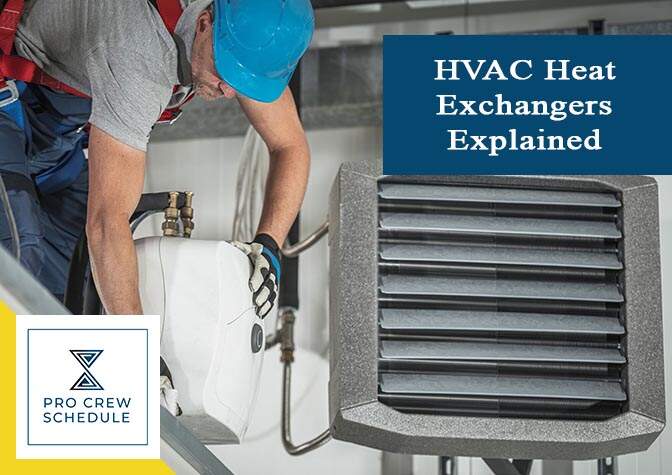Any HVAC technicians will be the first to tell their clients that HVAC equipment doesn’t make cold energy. Instead, it only transfers thermal (heat) energy from one particular location to another. Based on the Second Law of Thermodynamics, heat typically flows from high-temperature zones to low-temperature zones. Hence, the HVAC system is solely responsible for reversing the natural flow, eliminating hot air from buildings during hot summers, and placing it in buildings during cold winters.
So how everything possibly happens? The answer to this question caters to heat exchangers. For this blog, let’s discover the purpose of heat exchangers, including their different types and building services applications.
What is HVAC Heat Exchangers?
A heat exchanger is a device that is responsible for transferring thermal energy from one medium to another. This device supports the heating and cooling of buildings and helps engines and machines work more efficiently. Depending on the heat exchanger type to deploy, the heat transferring process could be liquid-to-liquid, gas-to-gas, or liquid-to-gas. Other design characteristics for heat exchangers, including construction components and materials and flow configurations, also help categorize and classify the types of heat transfer accessible.
All heat exchangers generally operate under the same basic principles. Yet, the devices can be categorized and classified in various ways based upon their design characteristics. Here are the three major characteristics by which a heat exchanger can be classified:
- Flow configuration – refers to the flow arrangement of a heat exchanger that depicts the direction of fluids within the device in relation to each other.
- Heat transfer mechanism – single-phase and two-phase heat transfer are the two common types of mechanisms. Each mechanism is different from one to the other.
- Construction method – in the previous portion, heat exchangers are classified based upon the type of flow configuration deployed. This particular section classified them based on construction.
To further understand how heat exchangers work, HVAC technicians need to know the entire process. First, they need to look first at the role this device has played in a gas furnace and air conditioner in HVAC systems. Second, they should prioritize using the construction scheduling software for project management purposes. This advanced tool is designed to support construction professionals when managing projects and crew.
Air Conditioners in Using Heat Exchanger
Air conditioners eliminate heat from indoor spaces and then transfer it outdoors. Refrigerant is one of the significant chemicals; it often relies mainly upon this process. Refrigerant is responsible for absorbing, carrying, and releasing heat as it transforms from a gas to liquid. During the refrigeration process, everything will be back again in normality. Here are the different steps to follow:
1. In the air conditioners, the refrigerant channels move heat as it goes through various components.
2. The refrigerant often starts as a liquid with low-pressure in the evaporator coils.
3. A fan blows the warm air in the indoor space across the coils. On the other hand, the refrigerant transforms into a vapor as it starts to absorb the heat from the air. In return, it cools down the room.
4. The refrigerant travels into the compressors typically located outdoors, where a warm low-pressure gas is present. It will start converting into a high-pressure where hot gas is formed.
5. The refrigerants move into the condenser immediately. Here, HVAC technicians have to observe the results firmly.
6. As air flows over the condensers, it will carry away the heat from the refrigerant, causing it to change again into a high-pressure, cool liquid. Using a project management software, it is easier for HVAC technicians to track every update under any given circumstance.
7. The refrigerant cools off even more in the expansion valve. It usually happens before returning to the evaporator to get more heat and carry it out of the buildings.
Note: While the whole air conditioning unit can be considered the heat exchanger between indoor and outdoor spaces, the condensers are the significant part accountable for heat transfer within the air conditioner.
A Gas Furnace in Using Heat Exchanger
For decades, a gas furnace has been one of the most well-known appliances for indoor heating spaces during cold winter seasons. This set of units employs heat exchangers to raise the air temperature before diffusing it to the entire building via registers and ducts. Take a look below:
1. Burner will generate combustion gases and then send them through the first opening and back into the heat exchangers.
2. A blower channels the indoor air over the exteriors of the heat exchangers at the very same time.
3. The heat exchanger utilizes the combustion gases to warm the air intentionally. It will then distributed around the indoor space.
4. Exhaust gases during the combustion process will be released through the flue. Here, HVAC technicians have to monitor the process. Hence, it is crucial to deploy the best construction management technology to track the ongoing procedure further.
Moreover, the heat exchangers in a gas furnace usually play two crucial roles – keeping toxic combustion gases away from the heated air and exchanging heat from the process to the air blown into it.
6 Basic Types of HVAC Heat Exchanger
The heat exchangers are popular devices for a unique purpose – to increase the HVAC system’s energy efficiency by transferring heat between two fluids or gases. For project management purposes, subcontractor scheduling software is best to use and deploy during work and project execution. Both tools might have different applications but are equally advantageous in many ways.
Here, let’s begin discovering the different types of heat exchangers intended for HVAC purposes.
1. Fixed Plate
This type of heat exchanger does not have any moving parts. Instead, it has fixed plates that are consecutively arranged and are separate from one to the other. Both the fluids and gases flow separately in these plates. Then, the relocation of heat will take place between them. The flow can either be cross flow or counter flow.
2. Rotary Wheel
This heat exchanger type usually has a large surface cylinder commonly attached to the shafts. Inside the shafts is a gas permeable material. Whenever the cylinder rotates, the gases will move in a counter flow pattern to the shafts in an axial way. The warm gas’s heat will be absorbed by the gas permeable material and transferred to the colder gas.
In some cases, hydroscopic materials are placed on the gas permeable to absorb the moisture. Therefore, the moist gas becomes drier and transfer it to the dry gas. Also, both sensible and latent heat is transferred as well in the system.
3. Heat Pipe
This heat exchanger has a condenser and an evaporator separated by the plates. It also has tubes running parallel that are separated from each other. On the side of evaporators, hot air can transfer its energy to the liquid refrigerants. The vapor refrigerant passes through the pipes to the condenser side.
The opposite process will now take place where cold air passes over the vapor refrigerants. After transferring the energy, the vapor refrigerant turns into liquid and will flow through the pipes. This heat exchanger type commonly uses parallel flow patterns.
4. Hot Gas
The HVAC system’s compressor usually generates heat by compressing refrigerants. The heat can be captured and then used for domestic heating water. And for this specific purpose, a heat exchanger is often set-up in between the condenser and compressors. Hence, the water that needs to be heated will be circulated through the heat exchangers with a pump’s support whenever the HVAC system is on.
HVAC technicians should be attentive in this matter. Whatever happens, while the process is going on must be observed and documented. Any complicated and detailed approach is best monitored using any of the construction project management trends. The software tool allowed crew members to get project updates and can also communicate and collaborate with one another consistently.
5. Hot Flue Gas
An arrangement comprising of a series of water jackets or pipes are often made in the boiler exhaust. By doing so, it immediately transfers the heat. The hot flue gases from the boilers can also be used to fuel oil or heat water. It can primarily use in preheating the feed water.
Water jackets are placed at the sides of a reciprocating engine and gas turbines to let the generated heat absorbed quickly. The heated gas is forced into the shells, where the transfer of heat to the water will take place through the tubes.
6. Shell and Tube
Shell and tube kind of heat exchangers are the most common type to use. These devices are constructed of either a series of parallel tubes or a single tube. These tubes are enclosed within a cylindrical pressure vessel or a sealed. The heat exchangers’ design means that fluids flow through the small tube and the other fluids flow around, outside, or between the sealed shells.
Finned tubes are another common design characteristic of this heat exchanger. Moreover, some other types of shell and tube heat exchangers available today include a double pipe and helical coil.
Key Takeaways
Lesser energy to heat or cool buildings only means more energy-efficient HVAC systems are needed. HVAC technicians know that heat exchangers do the heaving lifting and can make an HVAC system more efficient. That is why technicians must have a better understanding of heat exchangers. Therefore, getting a complete scope of heating and cooling systems with heat exchangers is necessary.







